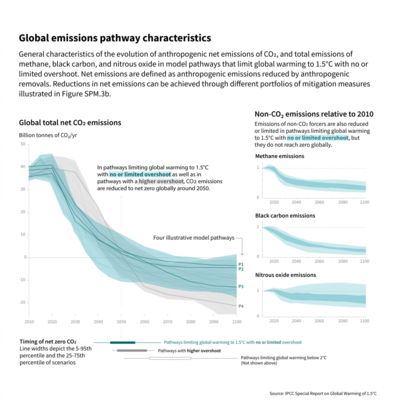Emission Pathways
Pathway Characteristics

Source:IPCC SR15 Summary for Policy Makers
Pathway Description
Emission pathways define the means by which CO2 emissions are reduced over time to achieve and maintain a specific level of CO2 in the atmosphere and oceans. In the IPCC SR15 Report the level of CO2 targeted is that which produces a maximum 1.5°C of global warming since the years 1850-1900.
In model pathways with no or limited overshoot of 1.5°C global warming, global net anthropogenic CO2 emissions decline by about 45% from 2010 levels by 2030 and attain net zero emissions around 2050. In other model pathways where the target is 2°C global warming, global net anthropogenic CO2 emissions decline by about 25% from 2010 levels by 2030 and attain net zero emissions around 2070.
Mitigation Portfolios
CO2 reduction pathways can involve a variety of mitigation portfolios, each striking a different balance between lowering energy and resource intensity, rate of decarbonization, and reliance on carbon dioxide removal. Each pathway has its own set of potential synergies and trade-offs that make it more or less compatible with sustainable development.
Non-CO2 reduction
In addition to reductions in CO2 emissions, pathways limiting global warming to 1.5°C with no or limited overshoot require deep reductions in methane and black carbon (35% or more for both by 2050 relative to 2010). In addition measures to reduce nitrous oxide levels and methane from agriculture are also required. These pathways also reduce most cooling aerosols, which temporarily offsets mitigation effects for two to three decades.
One additional advantage of non-CO2 removal is the improvement of air quality, with immediate population health benefits.
Carbon Budget
A carbon budget in the present context is the total amount of equivalent anthropogenic CO2 emissions released since pre-industrial times which allows the Earth to remain within a level of 1.5°C global warming. The amount of CO2 emissions is measured in gigatons of CO2 (GtCO2). By the end of 2017 the total anthropogenic emissions of CO2 since 1850-1900 was approximately 2200 +/- 320 GtCO2. The remaining amount of CO2 in the total carbon budget is uncertain, but values range from 420 GtCO2 to 770 GtCO2.
These calculations are subject to influence by other sources of CO2 release into the atmosphere. In addition, methane release also contributes to the equivalent CO2 value of the carbon budget and can occur as a result of thawing of permafrost, and methane release from wetlands, livestock, and waste disposal.
Energy Systems
Pathways leading to 1.5°C global warming with no or limited overshoot utilize energy systems with some or all of the following characteristics:
- lower energy use
- enhanced energy efficiency
- fast electrification of energy end use
- low-emission energy sources
- renewable energy sources
In addition to the above, renewable energy such as wind and solar and electricity storage technologies have substantially improved over the past few years. This may mean a potential transition in electricity generation.
Industry
Reduction of CO2 emissions in industry is achieved by new and existing technologies and practices:
- electrification
- hydrogen
- sustainable bio-based feedstocks
- product substitution
- carbon capture, utilization and storage (CCUS)
These options are technically viable, but their large-scale deployment may be limited by economic, financial, human capacity and institutional constraints.
In industry, emissions reductions by energy and process efficiency by themselves are insufficient for limiting warming to 1.5°C with no or limited overshoot.
Urban and Infrastructure systems
Limiting global warming to 1.5°C in urban and infrastructure systems involves the following:
- changes in land and urban planning practices
- deep emissions reductions in transport and buildings
- application of energy efficiency options
- increased use of electricity in buildings
- increased use of low-emission fuels in transportation
Land Use
Various applications of land use are found in all pathways leading to 1.5°C global warming with no or limited overshoot. There are profound challenges in these pathways to sustainable management of the land. These challenges involve use of the land for:
- human settlements
- food
- livestock feed
- fiber
- bioenergy
- carbon storage
- biodiversity
- ecosystem restoration
- less resource intensive diets
Overcoming these challenges would require dealing with socio-economic, institutional, technological, financing and environmental barriers that differ across regions.
Carbon Dioxide Removal (CDR)
All pathways that limit global warming to 1.5°C make use of carbon dioxide removal (CDR) in one form or another. The various methods employed by CDR are:
- afforestation
- reforestation
- land restoration and soil carbon sequestration
- bioenergy with carbon capture and storage (BECCS)
- direct air carbon capture and storage (DACCS)
- agriculture, forestry and land use (AFOLU)
- enhanced weathering
- ocean alkanlinization
CDR is used to correct temperature overshoot, where the target global warming level (e.g. 1.5°C) is exceeded, and it is necessary to extract carbon dioxide from the atmosphere in order to return the global temperature to the target level.
There are additional benefits to some CDR measures, such as AFOLU, which can lead to improved biodiversity, soil quality, and local food security.